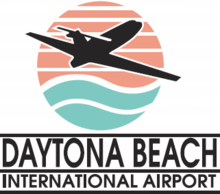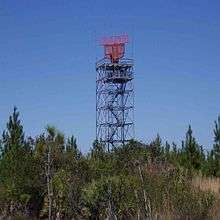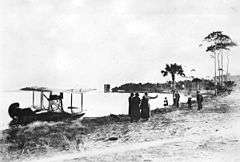Daytona Beach International Airport
| Daytona Beach International Airport | |||||||||||||||||||
|---|---|---|---|---|---|---|---|---|---|---|---|---|---|---|---|---|---|---|---|
 | |||||||||||||||||||
 Aerial view of runway 34, November 3, 2007. The speedway can be seen on the left. | |||||||||||||||||||
|
IATA: DAB – ICAO: KDAB – FAA LID: DAB – WMO: 74787 | |||||||||||||||||||
| Summary | |||||||||||||||||||
| Airport type | Public | ||||||||||||||||||
| Owner | County of Volusia | ||||||||||||||||||
| Serves | Daytona Beach, Florida, US | ||||||||||||||||||
| Elevation AMSL | 33 ft / 10 m | ||||||||||||||||||
| Coordinates | 29°11′05″N 81°03′38″W / 29.18472°N 81.06056°WCoordinates: 29°11′05″N 81°03′38″W / 29.18472°N 81.06056°W | ||||||||||||||||||
| Website |
www | ||||||||||||||||||
| Map | |||||||||||||||||||
 DAB Location in Florida | |||||||||||||||||||
| Runways | |||||||||||||||||||
| |||||||||||||||||||
| Statistics (2010) | |||||||||||||||||||
| |||||||||||||||||||
Daytona Beach International Airport (IATA: DAB, ICAO: KDAB, FAA LID: DAB) is a county-owned airport three miles (5 km) southwest of Daytona Beach,[1] next to Daytona International Speedway, in Volusia County, Florida. The airport has 3 runways, a six-gate domestic terminal, and an international terminal. Daytona Beach is the headquarters of Embry-Riddle Aeronautical University.
History
The Beach
Before airplanes landed on the beach, automobiles raced. The beach had a smooth, hard, and relatively clean surface for anything with wheels and speed. Pilots soon caught on and used the beach as a runway. Hangars were built later and aircraft service was provided on beach. This former airport is one of only two beach airports that were successful. The other, Old Orchard Beach in Maine, was the starting point for at least five transatlantic flights during the 1920s and 1930s.[2]

The first flight on the beach was in 1906 by Charles K. Hamilton, using Israel Ludlow's glider. The glider was pulled by an automobile and actually took place in Ormond. He went as high as 150 feet (46 m) on his first try, and 250 feet (76 m) on the second, before crashing into a flagpole and surviving with a bruised knee.[2]
Numerous flights followed, including John A. D. McCurdy, the United States's 5th licensed pilot, in 1911, Phillips Page in 1912, and Ruth Law in 1913. Phillips Page has been credited for taking the first aerial photographs in Florida, while flying around the Hotel Clarendon in Daytona Beach. Many other pilots took to the skies above Daytona Beach before it was closed during the winter of 1929–30.[2]
Bethune Point

All flights were moved to the new location at Bethune Point, on the Halifax River. Eastern Air Transport was the first airline at Daytona Beach, certified to fly mail to Tampa and Orlando. The first flight crashed just after takeoff, due to a mechanical failure. The pilot was uninjured, and the mail was collected and sent out on another flight.[2]
Florida State Airways, Inc was formed in early 1930 in Daytona Beach. The airline carried passengers to other Florida cities and to the Bahamas on Ryan aircraft. In January 1930 Vice President of Operations, Bill Lindley, piloted a flight to Palm Beach. While on the descent, he never pulled out of the dive and went into Lake Worth at full throttle. The combination of Lindley's death and the depression soon ended most aviation activity in Daytona Beach.[2]
Municipal Airport
In late 1930 a 740-acre (299 ha) piece of land turned into the current airport, a few hundred feet from the main drag of International Speedway Blvd. The first name it was given was Sholtz Field, after the then Governor of Florida, who was from Daytona Beach. The airport began with two gravel runways, one 1,800 feet (550 m) long and one 2,100 feet (640 m). Before long the name became Daytona Beach Municipal Airport.[2]
Eastern Air Lines began passenger service, flying Kingbirds and Condors. After a few years Eastern did not re-bid, after the airmail route changes of 1934. In 1935 National Airlines won a bid on the cross-state route from Daytona Beach to St. Petersburg. In 1933, the airport was closed for repairs. National rerouted its flights to Jacksonville but Eastern became upset and called National's move an act of "buccaneers". National Airlines then referred to its service as being the "Buccaneer Route".[2]
Pre-War Expansion
In the late 1930s four 4000 by 150 feet (46 m) runways were built, all paved, allowing DC-2s and DC-3s. The terminal was on the south side of the airport.[2] For a short while in 1940 a zoo-keeper was hired to maintain the airport.
Naval Air Station Daytona Beach
When World War II broke out the US Navy took over and used the airport for training, calling it Naval Air Station Daytona Beach. New buildings were later used by Embry-Riddle Aeronautical University after their move from Miami in 1965.,[2][3] while others were used by the aviation department that later became the current aviation authority. Naval outlying fields (NOLFs) were built at Spruce Creek, New Smyrna, Ormond Beach and Bunnell that were shared with NAS Jacksonville, NAS Sanford and NAS DeLand.
NAS Daytona Beach conducted advanced training for Naval Aviators and enlisted Naval Aircrewmen of the US Navy and US Marine Corps in aircraft ranging from single seat F6F Hellcat and F4U Corsair fighters to the multi-seat SB2C Helldiver dive bomber. At the end of the war, NAS Daytona Beach was decommissioned and the auxiliary airfields were returned to local governments for civil use.
Post-War Expansion
Ownership reverted to the city of Daytona Beach in 1946. The November 1950 chart shows Runways 6, 10, 16 and 21, all 3990 to 4140 feet long, forming an asymmetric asterisk.
The April 1957 OAG lists eight departures a day on Eastern Airlines and four on National Airlines. A new passenger terminal was completed in 1958, along with a control tower. Jet flights began in December 1967 with Eastern operating Boeing 727s on a round trip routing of Miami (MIA) - Melbourne (MLB) - Daytona Beach (DAB) - Baltimore (BAL) - New York Kennedy (JFK). Also in 1967, National was serving the airport with Lockheed L-188 Electra turboprops with nonstop flights to Jacksonville and Orlando as well as direct, no change of plane service to Boston, New York City, Newark, Philadelphia, Norfolk, Charleston, Savannah, Miami, Tampa and West Palm Beach.[4] The 1968 AOPA Directory lists DAB's longest runway as being 5700 ft; however, this information may have not been up to date as the 1969 Directory lists a 7500 ft runway. Runways 6 and 16 were 150' wide, the two diagonal runways were closed, and a 3100' x 75' training runway had been constructed parallel to the main runway on the south side of the field. By 1969, National was operating Boeing 727 jet service from the airport with nonstop flights to Miami and Jacksonville as well as direct service to Washington D.C. National Airport and New York JFK Airport.[5]
Also in 1969 Volusia County took over management of the airport from the City of Daytona Beach and renamed it Daytona Beach Regional Airport. In the following decades Embry-Riddle expanded its campus on the northeast side of the field.
According to the February 1, 1976 edition of the Official Airline Guide (OAG), Eastern Airlines was operating flights from the airport with Lockheed L-1011 Tristar wide body jetliners on a routing of Daytona Beach - Atlanta - Omaha - Portland, OR - Seattle and was also operating Boeing 727-100, 727-200 and McDonnell Douglas DC-9-30 jets with nonstop flights from Atlanta, Charlotte, Jacksonville, Miami and New York LaGuardia Airport as well as direct one stop or two stop flights from Boston, Chicago, Cleveland, Los Angeles, Montreal, New York JFK Airport, New York Newark Airport, Raleigh/Durham and Washington D.C. National Airport (now Reagan Airport). This same OAG also lists flights operated by National Airlines with Boeing 727-100 and 727-200 jetliners nonstop from Jacksonville, Miami and Orlando with direct one stop service from New York, Newark and Tampa.[6]
By the mid-1980s a midfield control tower had been completed and the airport was being served by Eastern, Delta Air Lines and Continental Airlines.
During the 1980s and 1990s when American Airlines was operating a hub in Raleigh/Durham, the carrier flew several daily flights to Raleigh Durham International Airport. American ended service to Daytona Beach in 1994 as its Raleigh/Durham hub was shut down but then returned to the airport following its merger with US Airways in 2015.
In 1992 a larger two-level terminal opened and the previous terminal was converted to an international arrivals facility. These new buildings, along with extension of two runways to 10,500' and 6001', justified a name change to Daytona Beach International Airport.
According to the September 15, 1994 edition of the OAG, three airlines were operating mainline jet service into the airport: Delta, Continental and USAir. Delta was flying seven nonstop flights a day to Atlanta with Boeing 737-200 and McDonnell Douglas MD-80 jetliners, Continental was operating one daily nonstop to New York Newark Airport with an MD-80 jet and USAir was flying daily nonstops to Charlotte three times a day with Boeing 737-300 and 737-400 jetliners.[7] USAir would subsequently be renamed as US Airways and was then merged into American Airlines in 2015. There was also commuter propjet flights at this time from the airport nonstop to Miami flown by Gulfstream International Airlines with Beechcraft 1900 turboprops as well as nonstop service to Orlando operated by Delta Connection and USAir Express with Beechcraft 1900, Embraer EMB-120 Brasilia and Fairchild Swearingen Metroliner turboprops.
In 1996, international airline service was being operated by German air carrier LTU International with weekly Boeing 767 transatlantic nonstop flights from Dusseldorf, Germany.[8] The only other scheduled direct flights out of the country from the airport were later operated to the Bahamas with small Beechcraft twin turboprops flown by Vintage Props and Jets, a commuter airline.[2][3] On July 18, 2008 Vintage Props and Jets temporarily ceased operations and filed for Chapter 11 bankruptcy protection. International charters with wide body jetliners flown by several airlines are occasionally operated into the airport.
Besides flights provided by Eastern and National, in the past Daytona Beach has seen Delta Air Lines service from Cincinnati, Dallas, and New York, American Airlines flights from Raleigh-Durham, LTU International from Düsseldorf, Continental Airlines from Cleveland and Newark, United Airlines from Chicago and Washington DC, and AirTran Airways from Atlanta, Baltimore, and New York City. Except for American and Delta, these airlines subsequently ceased all service into the airport.
According to an article in the Daytona Beach News Journal released on September 28, 2010, Stephen J. Cooke, the director of the airport, was in talks with the recently merged Southwest/AirTran to begin service to Daytona. AirTran had served Daytona in the past competing with Delta on the Atlanta route and also operated routes to Baltimore and New York LaGuardia Airport as well. Southwest Airlines has never served Daytona. A Southwest spokesman stated at the time that it was too soon to discuss possible new service to DAB but talks were continuing. If Southwest were to serve Daytona it would likely be from numerous cities. This would increase competition and lower prices for an airport that had been a duopoly by Delta and US Airways for years.[9] US Airways subsequently merged with American Airlines and Southwest still does not serve Daytona Beach at the present time. However, JetBlue Airways has announced it will begin flying new nonstop Airbus A320 jet service to New York JFK Airport in early 2016.[10]
Facilities
Daytona Beach International Airport covers 1,800 acres (730 ha) and has three asphalt runways: 7L/25R, 10,500 x 150 ft. (3,200 x 46 m), 7R/25L at 3,195 x 100 ft. (974 x 30 m) and 16/34, 6,001 x 150 ft. (1,829 x 46 m).[1]
In the year ending April 30, 2010 the airport had 290,455 aircraft operations, average 796 per day: 97% general aviation, 1% airline, 2% air taxi and <1% military. 231 aircraft are based at this airport: 72% single engine, 16% multi-engine, 11% jet and 1% helicopters.[1]
Fixed base operators
- ATP Jet Center(formerly known as Precision Air Center and Lynch Air)
- Commonwealth Aviation
- SheltAir Aviation Services
- Yelvington Jet Aviation
Aviation Schools
- 1st Class Aviation School of Aeronautics
- Air America Flight Center
- ATP Flight School
- Spectrum Flying Club
- Daytona Aviation Academy
- Embry-Riddle Aeronautical University
- Phoenix East Aviation
- The Airline Academy
Airlines and destinations
Passenger
| Airlines | Destinations |
|---|---|
| American Eagle | Charlotte |
| Delta Air Lines | Atlanta |
| JetBlue Airways | New York–JFK |
Statistics
| Rank | City | Passengers | Carriers |
|---|---|---|---|
| 1 | Atlanta, Georgia | 234,407 | Delta |
| 2 | Charlotte, North Carolina | 79,664 | American Eagle |
See also
References
- 1 2 3 4 FAA Airport Master Record for DAB (Form 5010 PDF), effective November 18, 2010
- 1 2 3 4 5 6 7 8 9 10 Brown, Warren (1994). Florida's Aviation History. Largo, Florida: Aero-Medical Consultants, Inc. pp. 187–189.
- 1 2 "DBIA History". Volusia County, Florida. Retrieved June 26, 2007.
- ↑ http://www.timetableimages.com, April 30, 1967 National Airlines system timetable
- ↑ http://www.timetableimages.com, July 15, 1969 National Airlines system timetable
- ↑ Feb. 1, 1976 Official Airline Guide (OAG) North American Edition, Daytona Beach flight schedules
- ↑ Sept. 15, 1994 OAG Desktop Flight Guide, North American edition, Daytona Beach flight schedules
- ↑ http://www.departedflights.com, Oct. 1, 1996 Official Airline Guide (OAG), Dusseldorf flight schedules
- ↑ http://www.news-journalonline.com/news/local/east-volusia/2010/09/28/southwest-airlines-to-buy-airtran.html
- ↑ www/jetblue.com, Press Releases, New Daytona Beach Service
- ↑ http://www.transtats.bts.gov/airports.asp?pn=1&Airport=DAB&Airport_Name=Daytona%20Beach,%20FL:%20Daytona%20Beach%20International&carrier=FACTS
External links
| Wikimedia Commons has media related to Daytona Beach International Airport. |
- Daytona Beach International Airport (official site)
- Daytona Beach International Airport PDF brochure from CFASPP
- Precision Air Center, the fixed base operator (FBO)
- 1st Class Aviation School of Aeronautics (flight school)
- Ultimate Air Academy (flight school)
- Airline Transport Professionals (flight school)
- FAA Airport Diagram (PDF), effective January 7, 2016
- FAA Terminal Procedures for DAB, effective January 7, 2016
- Resources for this airport:
- AirNav airport information for KDAB
- ASN accident history for DAB
- FlightAware airport information and live flight tracker
- NOAA/NWS latest weather observations
- SkyVector aeronautical chart for KDAB
- FAA current DAB delay information